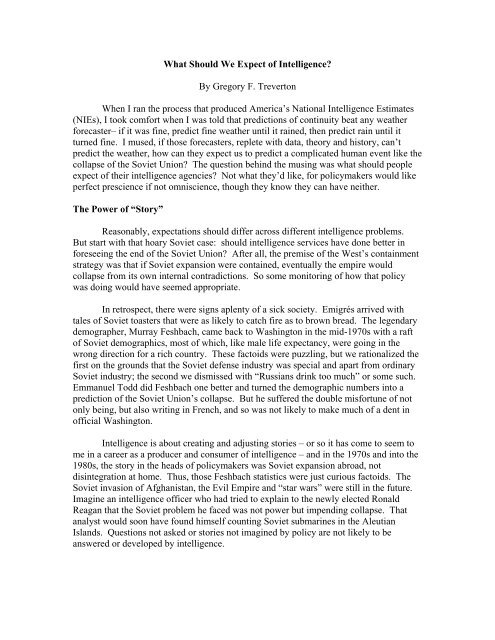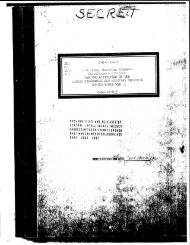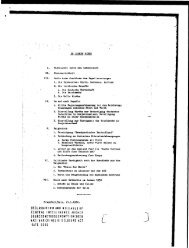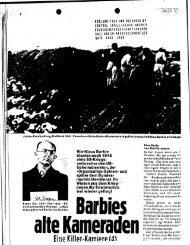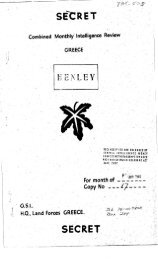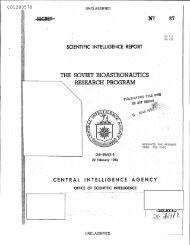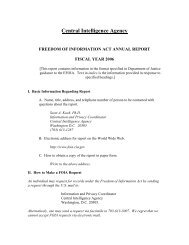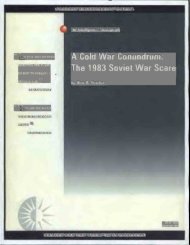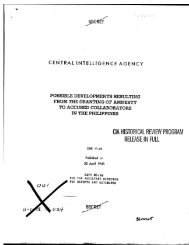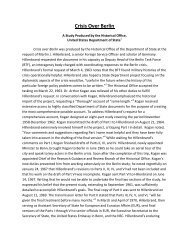2011-05-25 What Should We Expect of Intelligence - CIA FOIA
2011-05-25 What Should We Expect of Intelligence - CIA FOIA
2011-05-25 What Should We Expect of Intelligence - CIA FOIA
Create successful ePaper yourself
Turn your PDF publications into a flip-book with our unique Google optimized e-Paper software.
<strong>What</strong> <strong>Should</strong> <strong>We</strong> <strong>Expect</strong> <strong>of</strong> <strong>Intelligence</strong>?<br />
By Gregory F. Treverton<br />
When I ran the process that produced America’s National <strong>Intelligence</strong> Estimates<br />
(NIEs), I took comfort when I was told that predictions <strong>of</strong> continuity beat any weather<br />
forecaster– if it was fine, predict fine weather until it rained, then predict rain until it<br />
turned fine. I mused, if those forecasters, replete with data, theory and history, can’t<br />
predict the weather, how can they expect us to predict a complicated human event like the<br />
collapse <strong>of</strong> the Soviet Union? The question behind the musing was what should people<br />
expect <strong>of</strong> their intelligence agencies? Not what they’d like, for policymakers would like<br />
perfect prescience if not omniscience, though they know they can have neither.<br />
The Power <strong>of</strong> “Story”<br />
Reasonably, expectations should differ across different intelligence problems.<br />
But start with that hoary Soviet case: should intelligence services have done better in<br />
foreseeing the end <strong>of</strong> the Soviet Union? After all, the premise <strong>of</strong> the <strong>We</strong>st’s containment<br />
strategy was that if Soviet expansion were contained, eventually the empire would<br />
collapse from its own internal contradictions. So some monitoring <strong>of</strong> how that policy<br />
was doing would have seemed appropriate.<br />
In retrospect, there were signs aplenty <strong>of</strong> a sick society. Emigrés arrived with<br />
tales <strong>of</strong> Soviet toasters that were as likely to catch fire as to brown bread. The legendary<br />
demographer, Murray Feshbach, came back to Washington in the mid-1970s with a raft<br />
<strong>of</strong> Soviet demographics, most <strong>of</strong> which, like male life expectancy, were going in the<br />
wrong direction for a rich country. These factoids were puzzling, but we rationalized the<br />
first on the grounds that the Soviet defense industry was special and apart from ordinary<br />
Soviet industry; the second we dismissed with “Russians drink too much” or some such.<br />
Emmanuel Todd did Feshbach one better and turned the demographic numbers into a<br />
prediction <strong>of</strong> the Soviet Union’s collapse. But he suffered the double misfortune <strong>of</strong> not<br />
only being, but also writing in French, and so was not likely to make much <strong>of</strong> a dent in<br />
<strong>of</strong>ficial Washington.<br />
<strong>Intelligence</strong> is about creating and adjusting stories – or so it has come to seem to<br />
me in a career as a producer and consumer <strong>of</strong> intelligence – and in the 1970s and into the<br />
1980s, the story in the heads <strong>of</strong> policymakers was Soviet expansion abroad, not<br />
disintegration at home. Thus, those Feshbach statistics were just curious factoids. The<br />
Soviet invasion <strong>of</strong> Afghanistan, the Evil Empire and “star wars” were still in the future.<br />
Imagine an intelligence <strong>of</strong>ficer who had tried to explain to the newly elected Ronald<br />
Reagan that the Soviet problem he faced was not power but impending collapse. That<br />
analyst would soon have found himself counting Soviet submarines in the Aleutian<br />
Islands. Questions not asked or stories not imagined by policy are not likely to be<br />
answered or developed by intelligence.
The best point prediction <strong>of</strong> Soviet implosion I have seen was a slightly<br />
whimsical piece written by the British columnist, Bernard Levin, in September 1977. He<br />
got the process exactly right: change would come not from the bottom but from the top,<br />
from Soviet leaders who “are in every respect model Soviet functionaries. Or rather, in<br />
every respect but one: they have admitted the truth about their country to themselves, and<br />
have vowed, also to themselves, to do something about it.” Levin didn’t get the<br />
motivation <strong>of</strong> the high-level revolutionaries right – he imagined a deep-seated lust for<br />
freedom, rather than concern over the stagnating Soviet economy – but at least he had a<br />
story. For the sake <strong>of</strong> convenience, he picked the 200 th anniversary <strong>of</strong> the French<br />
revolution as the date – July 14, 1989.<br />
Closer to the end, <strong>CIA</strong> assessments were on the mark but still lacked for a story.<br />
The Agency had been pointing to a chronic slowdown in the Soviet economy since the<br />
1970s, and a 1981 report was blunt: “The Soviet pattern in many respects conforms to<br />
that <strong>of</strong> a less developed country. There is remarkably little progress toward a more<br />
modern pattern.” By 1982, <strong>CIA</strong> assessments concluded that Soviet defense spending had<br />
stopped growing, and the next year revised their previous assessments, concluding that<br />
defense spending had tailed <strong>of</strong>f beginning in 1976.<br />
Interestingly, those who could imagine the story didn’t believe it could be true.<br />
Unlike Levin, they did not believe the Soviet Union could be reformed from the top. And<br />
in that they turned out to be right. The director <strong>of</strong> America’s eavesdroppers, the National<br />
Security Agency, Lt. Gen. William Odom wrote in 1987 that the Mikhail Gorbachev’s<br />
program, if followed to its logical conclusion, would lead to Gorbachev’s political suicide<br />
and the collapse <strong>of</strong> the system. Because this did not seem what Gorbachev had in mind,<br />
he and others, including Robert Gates, then the Deputy Director <strong>of</strong> Central <strong>Intelligence</strong>,<br />
concluded that Gorbachev could not intend to do what he said he would.<br />
In fact, the Soviet Union didn’t have to end in 1991. Indeed, it might still be<br />
doddering along today but for the actions <strong>of</strong> that visionary bumbler, Mikhail Gorbachev,<br />
who understood his nation’s weakness but had no idea how to deal with it, and so set in<br />
motion an economic reform program that was pain for not much gain. <strong>What</strong> we could<br />
have expected <strong>of</strong> intelligence is not prediction but earlier and better monitoring <strong>of</strong><br />
internal shortcomings. <strong>We</strong> could also have expected some imaginings <strong>of</strong> competing<br />
stories to the then prevailing one. Very late, in 1990, an NIE, The Deepening Crisis in<br />
the USSR, did just that, laying out four different scenarios, or stories, for the next year.<br />
Puzzles and Mysteries<br />
When the Soviet Union would collapse was a mystery, not a puzzle. No one<br />
could know the answer. It depended. It was contingent. Puzzles are a very different<br />
kind <strong>of</strong> intelligence problem. They have an answer, but we may not know it. Many <strong>of</strong><br />
the intelligence successes <strong>of</strong> the Cold War were puzzle-solving about a very secretive<br />
foe: <strong>We</strong>re there Soviet missiles in Cuba? How many warheads did the Soviet SS-18<br />
missile carry?
Puzzles are not necessarily easier than mysteries – consider the decade it took to<br />
finally solve the puzzle <strong>of</strong> Osama bin Laden’s whereabouts. But they do come with<br />
different expectations attached. <strong>Intelligence</strong> puzzles are not like jig-saw puzzles in that<br />
we may not be very sure we have the right answer – the raid on bin Laden was launched,<br />
participants in the decision said, with odds that bin Laden actually was in the compound<br />
no better than six in ten. But the fact that there is in princple an answer provides some<br />
concreteness to what is expected <strong>of</strong> intelligence.<br />
That is especially so at the more tactical level <strong>of</strong> intelligence. In the simplest<br />
case, targeting (or producing, in wonderful Pentagonese, “desired mean points <strong>of</strong><br />
impact,” DMPIs, pronounced “dimpies”), the enemy unit either is or isn’t where<br />
intelligence says it is. And the intelligence will quickly be self-validating as the fighter<br />
pilot or drone targeter discovers whether the enemy unit is in fact there. The raid on bin<br />
Laden’s compound reflected the solution to a much more complicated puzzle, one that<br />
was a nice example <strong>of</strong> the various forms <strong>of</strong> collection and analysis working together. But<br />
in that case too it would have been immediately apparent to the raiders if bin Laden<br />
hadn’t been there.<br />
Another puzzle, whether Saddam Hussein’s Iraq had weapons <strong>of</strong> mass destruction<br />
(WMD) in 2002, drives home the point that because intelligence is a service industry,<br />
what policy <strong>of</strong>ficials expect from it shapes its work. In the WMD case, neither the U.S.<br />
investigating panel nor the British Butler report found evidence that political leaders had<br />
directly pressured intelligence agencies to come to a particular conclusion. Yet it is also<br />
fair to report that some intelligence analysts on both sides <strong>of</strong> the Atlantic did feel they<br />
were under pressure to produce the “right” answer – that Saddam Hussein had weapons<br />
<strong>of</strong> mass destruction.<br />
The interaction <strong>of</strong> intelligence and policy shaped the results in several other ways.<br />
Policy <strong>of</strong>ficials, particularly on the American side, when presented with a range <strong>of</strong><br />
assessments by different agencies, cherry picked their favorites (and sometimes grew<br />
their own cherries by giving credibility to information sources the intelligence services<br />
had discredited). As elsewhere in life, how the question was asked went a long way<br />
toward determining the answer. In this case, the question became simply “Does Saddam<br />
have WMD?” <strong>Intelligence</strong> analysis did broaden the question, but issues <strong>of</strong> how much<br />
threat, to whom and over what time frame got lost in the “does he?” debate. Moreover,<br />
U.S. intelligence was asked over and over about links between Iraq and al Qaeda. It<br />
stuck to its analytic guns – the link was tenous at best – but the repeated questions served<br />
both to elevate the debate over the issue and to contribute to intelligence’s relative lack <strong>of</strong><br />
attention to other questions.<br />
In the end, however, the most significant part <strong>of</strong> the WMD story was what<br />
intelligence and policy shared – a deeply held mindset that Saddam must have WMD.<br />
That mindset included outsiders like me who opposed going to war, as well as other<br />
European intelligence services whose governments were not going to participate in any<br />
war. For intelligence, the mindset was compounded by history, for the previous time<br />
around, in the early 1990s, U.S. intelligence had underestimated Iraqi WMD; it was not
going to make that mistake again. In the end, if most people believe one thing, arguing<br />
for another is hard. There is little pressure to rethink the issue, and the few dissenters in<br />
intelligence are lost in the wilderness.<br />
<strong>What</strong> should have been expected from intelligence in this case was a section in<br />
the assessments asking what was the best case that could be made that Iraq did not have<br />
WMD. That would not have made the slightest bit <strong>of</strong> difference in the rush to war, given<br />
the power <strong>of</strong> the prevailing mindset, but it would at least <strong>of</strong>fered intelligence agencies<br />
some protection from later criticism – fair enough – that they had not done their job.<br />
<strong>What</strong> policy <strong>of</strong>ficials expect from intelligence also shapes how intelligence is<br />
organized and what kind <strong>of</strong> people it hires. On the American side <strong>of</strong> the Atlantic, the<br />
crown jewel <strong>of</strong> intelligence products is the President’s Daily Brief (PDB), perhaps the<br />
most expensive publication per copy since Gutenberg. Often caricatured as “CNN plus<br />
secrets,” much <strong>of</strong> it is factoids from recent collection by a spy or satellite image or<br />
intercepted signal, plus commentary. On the British side <strong>of</strong> the ocean, there is less <strong>of</strong> a<br />
flood <strong>of</strong> current intelligence, and the assessments <strong>of</strong> the UK’s Joint <strong>Intelligence</strong><br />
Committee are, in my experience, <strong>of</strong>ten thoughtful. But on both sides <strong>of</strong> the ocean, the<br />
tyranny <strong>of</strong> the immediate is apparent. As one U.S. analyst put it to me: “<strong>We</strong> used to do<br />
analysis; now we do reporting.”<br />
The focus on the immediate, combined with the way intelligence agencies are<br />
organized, may have played some role in the failure to understand the contagion effects<br />
in the “Arab spring” <strong>of</strong> recent months. In the United States, especially, where analytic<br />
cadres are large, analysts have very specific assignments. The Egypt analysts are tightly<br />
focused on Egypt, perhaps even on particular aspects <strong>of</strong> Egypt. They would not been<br />
looking at ways events in Tunisia might affect Egypt. To be fair, the popular media<br />
probably overstated the contagion effect <strong>of</strong> events from one Arab country to the next, but<br />
that there was some such effect seems apparent in retrospect. Worse, my bet is that if<br />
asked whether events in Tunisia might affect Egypt, even slightly, those Egypt analysts<br />
would have said “no” with more or less disdain.<br />
In the end, what is expected <strong>of</strong> intelligence also shapes what capabilities it builds<br />
– and hires. At the tactical level, teams <strong>of</strong> young analysts from the big U.S. collection<br />
agencies (the National Security Agency for signals intelligence or SIGINT and the<br />
National Geospatial <strong>Intelligence</strong> Agency for imagery, or IMINT), organized into<br />
“geocells” have become adept at combining SIGINT and imagery, and adding what has<br />
been learned from informants in the battle zones, in order to identify events <strong>of</strong> interests,<br />
and ultimately provide those DIMPIs.<br />
The demand for those DIMPIs is plain enough, and the PDB’s unusually collected<br />
secrets are beguiling if not always very helpful. The demand from policy <strong>of</strong>ficials for<br />
more strategic, and perhaps longer-term, assessments is less clear. When asked, <strong>of</strong>ficials<br />
say they would like them: how could they answer otherwise? But in practice too <strong>of</strong>ten<br />
the response is: “That looks interesting. I’ll read it when there is time.” And there never<br />
is time. When I was at the National <strong>Intelligence</strong> Council (NIC) overseeing NIEs we had
a good idea. <strong>We</strong>’d do a short intelligence appraisal <strong>of</strong> an important foreign policy issue,<br />
and the State Department’s policy planners would add a policy paper. <strong>We</strong>’d then<br />
convene the deputies – the number twos in the various foreign policy agencies – over an<br />
informal lunch. The conversation would begin with the outcome the United States sought<br />
a decade out, then peel back to current policy. <strong>We</strong> got such a session on the deputies’<br />
calendar exactly once.<br />
Lacking demand, it is not at all clear that intelligence agencies either hire or train<br />
people who could do good strategic analysis – that is, analysis that locates choices in a<br />
wider context <strong>of</strong> other issues and perhaps a longer time stream. Most analysts are trained<br />
to look for measurable evidence and struggle with alternative possibilities, but are not<br />
always willing to venture beyond the facts and the level <strong>of</strong> policy description. To be<br />
sure, there are differences across agencies. The State Department’s Bureau <strong>of</strong><br />
<strong>Intelligence</strong> and Research, while small, does value deep expertise, letting analysts stay on<br />
a particular account for an entire career. By contrast, the analytic arm <strong>of</strong> the <strong>CIA</strong><br />
believes good analysts can add value quickly as they move from account to account. As<br />
a result, it has more the feel <strong>of</strong> a newsroom than a university.<br />
At the NIC, I came to think that, for all the technology, strategic analysis was best<br />
done in person. Indeed, I came to think that our real products weren’t those papers, the<br />
NIEs. Rather they were the NIOs, the National <strong>Intelligence</strong> Officers – experts not papers.<br />
<strong>We</strong> all think we can absorb information more efficiently by reading, but my advice to my<br />
policy colleagues was to give intelligence <strong>of</strong>ficers some face time. If policymakers ask<br />
for a paper, what they get inevitably will be 60 degrees <strong>of</strong>f the target. In 20 minutes,<br />
though, the intelligence <strong>of</strong>ficers can sharpen the question, and the policy <strong>of</strong>ficial can<br />
calibrate the expertise <strong>of</strong> the analyst. In that conversation, intelligence analysts can <strong>of</strong>fer<br />
advice; they don’t need to be as tightly restricted as on paper by the “thou shalt not traffic<br />
in policy” injunction. <strong>Expect</strong>ations can be calibrated on both sides <strong>of</strong> the conversation.<br />
And the result might even be better policy.<br />
Gregory F. Treverton is director <strong>of</strong> the Center for Global Risk and Security at the RAND<br />
Corporation, a nonpr<strong>of</strong>it institution that helps improve policy and decision-making<br />
through research and analysis. In government, he has served the U.S. Senate, the<br />
National Security Council and the National <strong>Intelligence</strong> Council. His most recent book<br />
on intelligence is <strong>Intelligence</strong> for an Age <strong>of</strong> Terror (Cambridge University Press, 2009).


